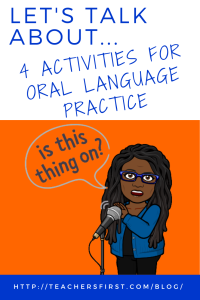As teachers, we have the unique opportunity to witness the transformative power of authentic spoken communication practice in our students. This not only cultivates essential language skills but also nurtures confidence, creativity, and learner agency. Today, let’s embark on a journey of exploration with four cross-curricular engaging activity ideas that harness student voice while fostering oral proficiency. So, let’s get ready to amplify their voices and see them blossom!
Activity 1: Collaborative Storytelling on Padlet
Ignite your students’ imaginative language use by challenging them to co-construct an original story arc using Padlet’s (reviewed here) voice recording feature. First, introduce the storytelling elements like characters, setting, and conflict. Then, have students take turns drafting and recording narrative sections that build suspense and detail. With each post, they’ll practice expressive reading, descriptive language, and narrative techniques. Imagine the pride when their combined voices bring an imaginative tale to life! Now, let’s think about ways to differentiate this activity, and get ready to be amazed by the creative sparks your students will ignite!
- Elementary: Provide story starters or word banks to scaffold language. Have students record shorter segments, taking turns to allow more frequent participation.
- Middle School: Have students create the settings and characters. Require the use of descriptive language and dialogue. Assign narrative techniques like foreshadowing, point of view, and personification.
- High School: Let students develop complex, coherent storylines in small groups incorporating literary devices like symbolism and figurative language.
- Multilingual Students: Allow students to record story segments in their home language first, then provide/create a translation in English
Activity 2: Audio Description of Artwork in Adobe Animate
Put high-level descriptive skills into practice by having students describe the artwork of their choice using Adobe Animate from Audio (reviewed here). They’ll first analyze visual details and composition principles. Then, they’ll map out a descriptive script capturing the essence and emotional resonance. Finally, students upload the image and record their description. This multimodal project synthesizes observation, vocabulary, and expression talents. To differentiate, try these ideas:
- Elementary: Pre-teach vocabulary words describing art elements and principles like color, line, and texture. Model visual analysis and description.
- Middle School: Require students to research and explain the artist’s background, style, and techniques incorporated in the piece.
- High School: Have students connect artwork to contextual themes, art movements, and cultural significance through their descriptive analysis.
- Multilingual Students: Provide bilingual description examples to emulate in the selected recording language.
Activity 3: Living History Monologues via Vocaroo
For a creative perspective-taking challenge, assign “Living History” monologues via the simple recording tool Vocaroo (reviewed here). Students research a notable historical figure and then depict that person’s experiences through a first-person narrative monologue. They’ll practice vivid characterization, vocal expression, and descriptive language, painting a picture of that figure’s life and historical context. Sharing these immersive monologues builds empathy alongside oral skills. Consider these differentiation options for your instructional situation:
- Elementary: Provide biographical information at an accessible reading level. Focus on chronological sequencing of critical events. Need help getting the correct information at the right level? Check out this OK2Ask archive on using Artificial Intelligence to do just that.
- Middle School: Require incorporating dialogue, motivations, obstacles faced, and rhetorical language techniques.
- High School: Ask students to connect figures to social movements, philosophies, and impacts. Use higher-level analysis and evaluative language.
- Multilingual Students: Encourage research of historical figures from cultural backgrounds related to students’ identities.
Activity 4: Scientific Discoveries on Presentio.us
Promote scientific communication capabilities by having students explore and present notable scientific discoveries using Presentio.us (reviewed here). Have students describe the fundamental principles involved, the discovery process and challenges, potential real-world applications, and societal impacts, both positive and concerning. This activity melds research, organization, descriptive language, and persuasive speaking – crucial skills for the next generation of scientists and innovators. Some ideas for differentiation include:
- Elementary: Have students focus on concrete descriptions of the discovery’s importance, process, and applications to everyday life.
- Middle School: Ask students to explain core scientific principles using content vocabulary and real-world examples/models.
- High School: Students should analyze complex theories, laws, and ethics involved, then present and refute opposing viewpoints.
- Multilingual Students: Compare strengths of precisely communicating complex science concepts across languages
By purposefully designing opportunities for students to communicate original ideas in creative ways orally, we’re empowering confident, expressive communication and higher-order thinking. These differentiation tips are just the beginning; you may need to develop additional options to engage diverse learners. Remember, these activities are adaptable and flexible, ensuring that every student can find their voice and shine in their own unique way.
Which activity excites you the most to amplify student voices in your classroom? I’d love to hear your creative twists and reflections on implementing these. Feel free to share any challenges you faced and how you overcame them. Let’s continue inspiring our students to develop their oral language skills!


